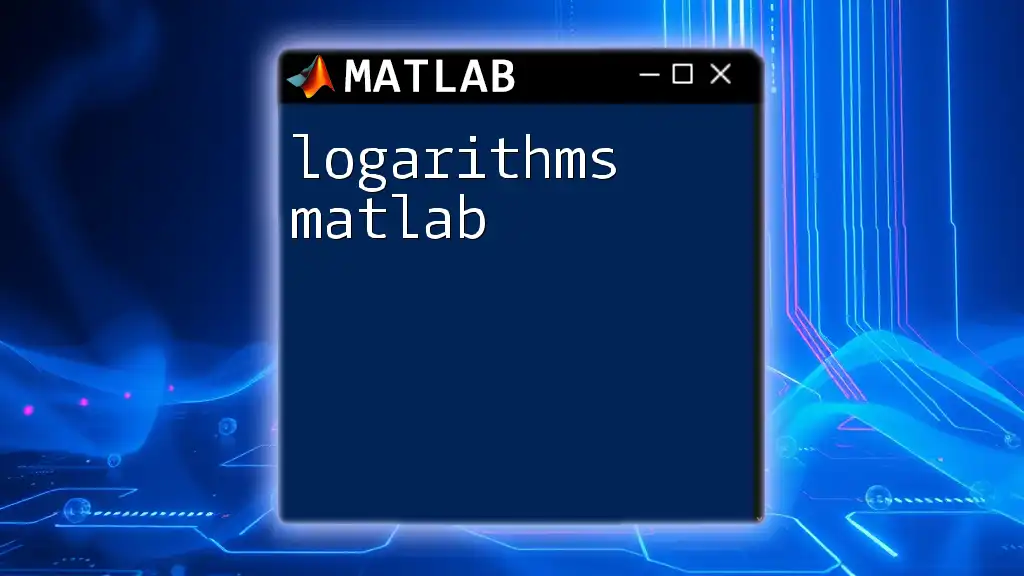In MATLAB, imaginary numbers can be represented using the imaginary unit `i` or `j`, allowing for complex number calculations alongside real numbers.
% Define a complex number with a real part and an imaginary part
z = 3 + 4i;
% Display the imaginary part
imaginaryPart = imag(z);
disp(imaginaryPart);
Understanding Imaginary Numbers
Definition of Imaginary Numbers
Imaginary numbers are defined as numbers that can be expressed in the form of a + bi, where a is a real number, b is a real number, and i is the imaginary unit representing the square root of -1. In MATLAB, instead of using i, the convention is to use j for the imaginary unit. Understanding imaginary numbers is crucial in various fields, including mathematics, physics, and engineering, where they provide solutions to equations that cannot be solved using real numbers alone.
Basic Properties of Imaginary Numbers
Imaginary numbers exhibit various arithmetic properties:
-
Addition and Subtraction: When adding or subtracting two imaginary numbers, you simply add or subtract their real parts and their imaginary parts separately. For example:
z1 = 2 + 3*j; z2 = 1 + 4*j; sumZ = z1 + z2; % Result: 3 + 7j -
Multiplication: When multiplying imaginary numbers, you can apply the distributive property and remember that j^2 = -1. For example:
productZ = z1 * z2; % Result will be (2*1 - 3*4) + (3*1 + 2*4)j = -10 + 18j -
Division: Division involves multiplying the numerator and denominator by the conjugate of the denominator to eliminate the imaginary part from the denominator.
Complex Numbers in MATLAB
Complex numbers in MATLAB can be managed with ease. They represent both real and imaginary components together. You can create complex numbers directly by using the imaginary unit j (or i).
To calculate the magnitude and phase (or angle) of a complex number, you can use:
z = 3 + 4*j; % Complex number
magnitude = abs(z); % Result: 5
phase = angle(z); % Result: 0.93 radians (approx.)
Here, the magnitude is calculated using the formula \( \sqrt{a^2 + b^2} \) while the phase is determined by \( \tan^{-1}(\frac{b}{a}) \).

Using Imaginary Numbers in MATLAB
Creating Imaginary Numbers
To create imaginary numbers in MATLAB, you can simply define them like so:
z = 3 + 4*j; % Example of creating an imaginary number
You can use either j or i interchangeably, though it is often a good idea to be consistent within your code to avoid confusion.
Displaying Imaginary Numbers
To display both the real and imaginary parts of a complex number, the `real()` and `imag()` functions are helpful:
realPart = real(z); % Result: 3
imagPart = imag(z); % Result: 4
fprintf('Real Part: %.2f, Imaginary Part: %.2fj\n', realPart, imagPart);
This provides a clear output of the components that make up your complex number.

Advanced Operations with Imaginary Numbers
Arithmetic Operations
To go further with arithmetic operations involving imaginary numbers:
- Subtraction is straightforward, subtracting the real and imaginary parts separately.
- Multiplicative Inverses can be found even for complex numbers, employing the conjugate as mentioned previously.
z1 = 2 + 3*j;
z2 = 1 + 4*j;
differenceZ = z1 - z2; % Result: 1 - 1j
Complex Conjugates
A complex conjugate of a number z = a + bi is given by a - bi. In MATLAB, you can compute the complex conjugate using the `conj()` function.
conjZ = conj(z); % Result: 3 - 4j
Understanding complex conjugates is crucial when dividing complex numbers because it helps to rationalize the denominator.
Plotting Imaginary and Complex Numbers
Visualizing complex numbers is helpful for interpreting their relationships. In MATLAB, you can plot complex numbers directly on the complex plane using the `plot` function:
figure;
z = [1+2*j, 3+4*j, 5+6*j]; % Example vector of complex numbers
plot(real(z), imag(z), 'ro'); % Plot imaginary numbers in red
xlabel('Real Part');
ylabel('Imaginary Part');
title('Imaginary and Complex Numbers in the Complex Plane');
grid on;
This allows for an intuitive understanding of how complex numbers relate to one another geometrically.

Applications of Imaginary Numbers in MATLAB
Signal Processing
Imaginary numbers play a critical role in signal processing, especially in the analysis of waveforms and frequency response. For example, they are used in the Fourier Transform, which converts a signal from the time domain to the frequency domain, allowing for a detailed analysis.
Electrical Engineering
In electrical engineering, imaginary numbers are indispensable for representing alternating currents (AC). They are used in calculating impedances in AC circuits where resistors, inductors, and capacitors interact. The imaginary unit effectively represents the phase shifts that occur in these systems.
Control Systems
In control systems engineering, imaginary numbers are crucial for stability analysis, particularly when working with the s domain in Laplace transforms. They facilitate the modeling of dynamic systems and feedback control, allowing engineers to ensure system stability and performance.

Conclusion
Understanding imaginary numbers in MATLAB is fundamental for anyone working in fields like mathematics, physics, and engineering. By mastering the operations and applications associated with these numbers, you can enhance your computational skills and apply them to diverse real-world problems.

Additional Resources
For further learning, consider checking out books and online courses focused on MATLAB programming and complex analysis. Engaging with the official MATLAB documentation will also provide deeper insights and comprehensive guidelines for using imaginary and complex numbers effectively in your projects.

















